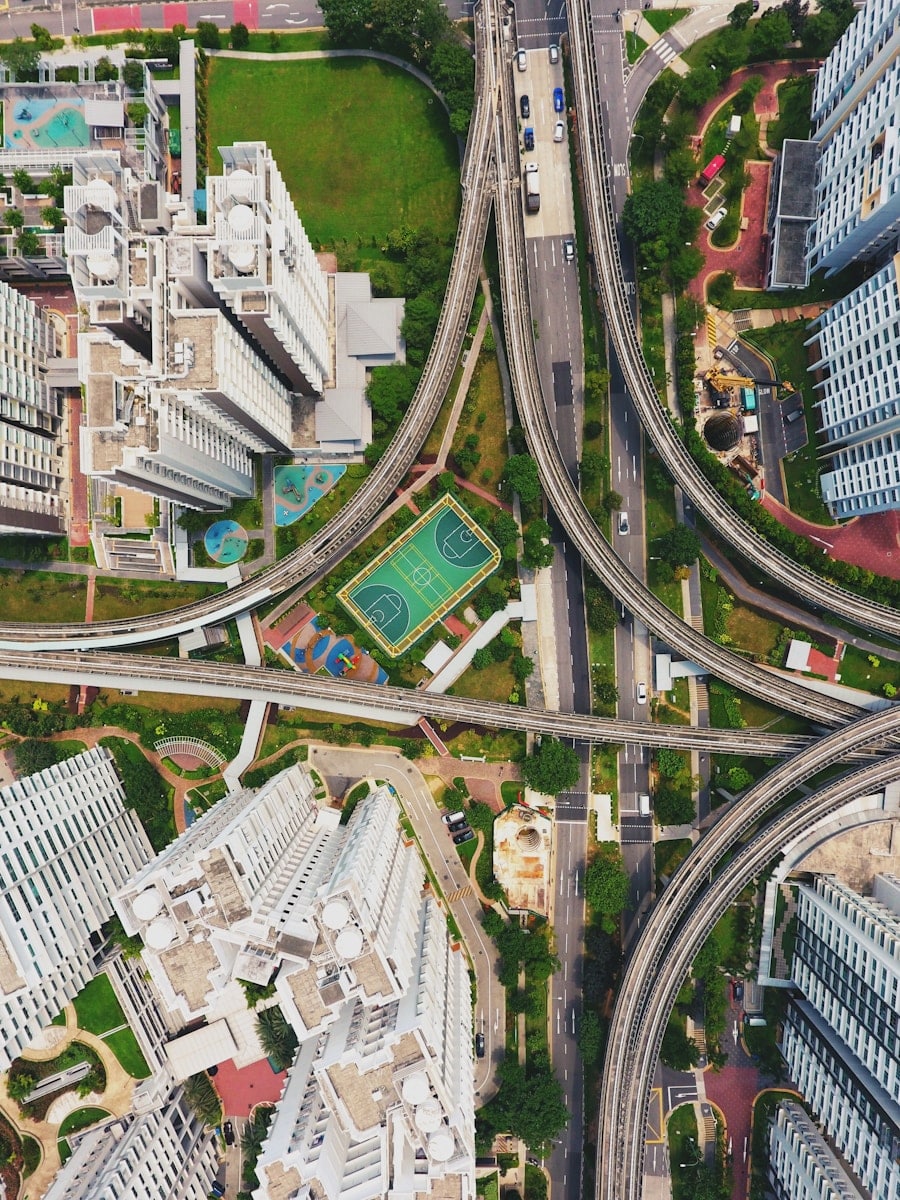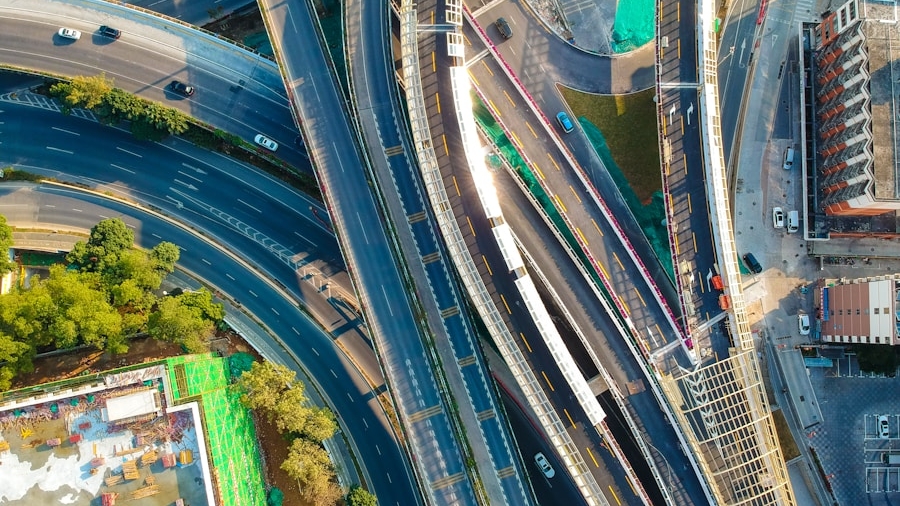The integration of artificial intelligence (AI) into urban infrastructure represents a transformative shift in how cities are designed, managed, and evolved. As urban areas continue to expand, the challenges associated with infrastructure—such as traffic congestion, waste management, and energy consumption—become increasingly complex. AI technologies offer innovative solutions that can enhance efficiency, reduce costs, and improve the quality of life for urban residents.
By leveraging vast amounts of data, AI can analyze patterns, predict outcomes, and optimize systems in ways that were previously unimaginable. This technological revolution is not merely about automation; it is about rethinking the very fabric of urban living. Urban infrastructure encompasses a wide range of systems, including transportation networks, utilities, public spaces, and housing.
The traditional approaches to designing and maintaining these systems often fall short in addressing the dynamic needs of growing populations.
For instance, machine learning algorithms can analyze traffic patterns in real-time, allowing city planners to adjust traffic signals dynamically to alleviate congestion.
This capability not only enhances mobility but also contributes to reducing emissions and improving air quality. As cities grapple with the dual pressures of population growth and climate change, the role of AI in urban infrastructure becomes increasingly critical.
Key Takeaways
- AI is revolutionizing urban infrastructure by optimizing processes and improving efficiency.
- Urban infrastructure has a significant environmental impact, and AI can help minimize this impact through smart design and management.
- AI has the potential to design sustainable urban infrastructure by analyzing data and predicting future needs.
- Case studies show how AI-driven projects have successfully created sustainable urban infrastructure, such as smart energy grids and efficient transportation systems.
- Challenges and limitations of using AI in urban infrastructure design include data privacy concerns and the need for human oversight and intervention.
The Environmental Impact of Urban Infrastructure
Environmental Consequences of Urbanization
The building sector alone accounts for nearly 40% of global energy-related carbon dioxide emissions. Moreover, urban sprawl often encroaches on natural habitats, disrupting ecosystems and biodiversity. The challenge lies in balancing the need for infrastructure development with the imperative to protect the environment.
Vulnerability of Urban Areas to Climate Change
Urban areas are particularly vulnerable to the effects of climate change, including rising temperatures, increased flooding, and extreme weather events. Poorly designed infrastructure can exacerbate these issues, leading to greater vulnerability for urban populations.
The Need for Sustainable Design Practices
For instance, inadequate drainage systems can result in severe flooding during heavy rainfall, causing damage to property and infrastructure while also posing risks to public health. As cities continue to grow, the environmental impact of urban infrastructure must be addressed through sustainable design practices that prioritize resilience and ecological integrity.
The Potential of AI in Designing Sustainable Urban Infrastructure

AI holds immense potential for revolutionizing the design of sustainable urban infrastructure by enabling more efficient resource use and promoting environmentally friendly practices. One of the key advantages of AI is its ability to process and analyze large datasets from various sources, including satellite imagery, sensor networks, and social media. This data can provide insights into urban dynamics, helping planners identify areas where infrastructure improvements are needed most urgently.
For example, AI can analyze traffic data to determine optimal locations for new public transit routes or bike lanes, thereby encouraging sustainable transportation options. Furthermore, AI can facilitate the design of energy-efficient buildings by optimizing architectural layouts and materials based on environmental conditions. Machine learning algorithms can predict energy consumption patterns and suggest modifications that enhance energy efficiency.
For instance, AI-driven simulations can model how different building designs will perform under varying weather conditions, allowing architects to make informed decisions that minimize energy use while maximizing comfort for occupants. This approach not only reduces operational costs but also contributes to lowering the overall carbon footprint of urban developments.
Case Studies of AI-Driven Sustainable Urban Infrastructure Projects
Several cities around the world have begun to implement AI-driven projects aimed at creating more sustainable urban infrastructure. One notable example is Singapore’s Smart Nation initiative, which leverages AI and data analytics to enhance urban living. The city-state has deployed a network of sensors throughout its urban landscape to monitor traffic flow, air quality, and energy consumption in real-time.
By analyzing this data with AI algorithms, Singapore’s planners can make informed decisions about traffic management and resource allocation, ultimately leading to reduced congestion and improved environmental conditions. Another compelling case study is Barcelona’s use of AI in its smart waste management system. The city has implemented sensors in waste bins that monitor fill levels and optimize collection routes based on real-time data.
This approach not only reduces fuel consumption by waste collection vehicles but also minimizes the environmental impact associated with unnecessary trips. By employing AI to streamline waste management processes, Barcelona has demonstrated how technology can enhance urban sustainability while improving operational efficiency.
Challenges and Limitations of Using AI in Urban Infrastructure Design
Despite the promising potential of AI in urban infrastructure design, several challenges and limitations must be addressed for successful implementation. One significant hurdle is the availability and quality of data. Effective AI algorithms rely on large datasets that are accurate and representative of real-world conditions.
In many cases, cities may lack comprehensive data collection systems or face issues related to data privacy and security. Without reliable data, the effectiveness of AI-driven solutions can be severely compromised. Additionally, there is a risk that over-reliance on AI could lead to unintended consequences if not carefully managed.
For instance, algorithms may inadvertently perpetuate existing biases present in historical data or fail to account for unique local contexts. This could result in infrastructure designs that do not adequately serve all community members or exacerbate existing inequalities. Therefore, it is crucial for urban planners and policymakers to approach AI integration with caution and ensure that human oversight remains a fundamental component of the design process.
The Role of Collaboration between AI and Human Designers

The Limitations of AI in Urban Planning
Designers bring a wealth of experience and knowledge about local communities, cultural nuances, and social dynamics that algorithms alone cannot replicate.
The Power of Human-AI Collaboration
Collaboration between AI systems and human designers can lead to innovative solutions that address complex urban challenges more holistically. For example, while an AI algorithm may identify optimal locations for green spaces based on environmental data, human designers can consider factors such as community needs, accessibility, and aesthetic preferences when finalizing those designs.
Towards a More Inclusive Approach to Urban Planning
This synergy between technology and human expertise fosters a more inclusive approach to urban planning that prioritizes both sustainability and social equity.
The Future of AI in Shaping Sustainable Urban Infrastructure
Looking ahead, the future of AI in shaping sustainable urban infrastructure appears promising yet requires careful navigation of ethical considerations and practical challenges. As cities continue to evolve in response to climate change and population growth, the demand for innovative solutions will only increase. AI technologies are likely to play an increasingly central role in addressing these challenges by providing real-time insights that inform decision-making processes.
Moreover, advancements in machine learning and predictive analytics will enable cities to become more adaptive and resilient in the face of changing conditions. For instance, AI could facilitate dynamic resource allocation during emergencies or optimize energy distribution based on real-time demand fluctuations. As cities embrace smart technologies, the potential for creating sustainable urban environments will expand significantly.
Establishing frameworks for ethical AI use in urban planning will be crucial to ensure that technology serves the public good rather than exacerbating existing inequalities or compromising privacy.
The Importance of AI in Creating More Sustainable Cities
The integration of artificial intelligence into urban infrastructure design represents a pivotal opportunity for cities to address pressing environmental challenges while enhancing quality of life for residents. By harnessing the power of data-driven insights and optimizing resource use through innovative technologies, cities can create more sustainable environments that are resilient to future challenges. However, this transformation requires a thoughtful approach that balances technological advancements with human creativity and ethical considerations.
As we move forward into an era where urbanization continues unabated, the role of AI in shaping sustainable cities will become increasingly vital. By fostering collaboration between technology and human designers while addressing challenges related to data quality and equity, we can pave the way for a future where urban infrastructure not only meets the needs of today but also preserves the planet for generations to come.
In a recent article on ENICOMP, the benefits of using NeuronWriter SEO NLP optimization to boost content were discussed. This technology could be incredibly useful in the context of designing more sustainable urban infrastructure with the help of AI. By optimizing content related to sustainable design practices, cities can better communicate their initiatives and engage with the public. To learn more about NeuronWriter SEO NLP optimization, check out the article here.
FAQs
What is the role of AI in designing sustainable urban infrastructure?
AI plays a crucial role in designing sustainable urban infrastructure by analyzing large amounts of data to optimize energy usage, reduce waste, and improve overall efficiency in urban environments.
How does AI contribute to reducing environmental impact in urban infrastructure?
AI helps reduce environmental impact by identifying opportunities for energy conservation, waste reduction, and the implementation of renewable energy sources in urban infrastructure design.
What are some examples of AI applications in sustainable urban infrastructure design?
AI applications in sustainable urban infrastructure design include smart grid systems, traffic management, waste management, and building energy management systems.
How does AI improve the efficiency of urban infrastructure systems?
AI improves efficiency by analyzing data to optimize resource allocation, predict maintenance needs, and identify opportunities for improvement in urban infrastructure systems.
What are the potential benefits of integrating AI into urban infrastructure design?
The potential benefits of integrating AI into urban infrastructure design include reduced energy consumption, lower operational costs, improved resilience to environmental challenges, and enhanced quality of life for urban residents.

